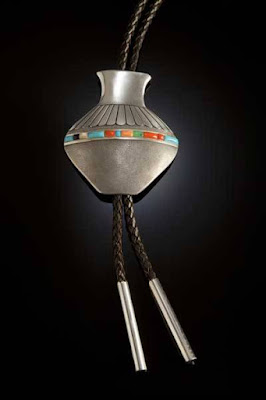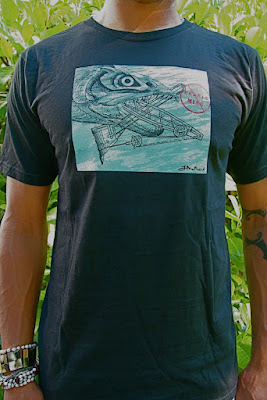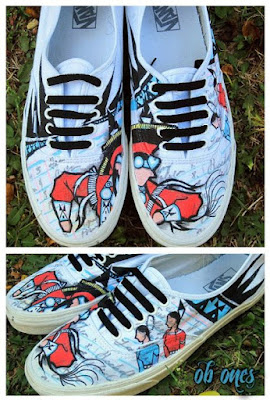So, Etsy lets you 'curate' lists of favorite items based on themes. I put together two 'Treasury Lists' and found out that it was a lot of fun (and borderline-addictive) to look through everyone's work and pick out some cool pieces that fit your latest interest (first, I was obsessed with all the pretty silver stuff, then red stuff, and then with teeny tiny baby stuff, and then with turquoise stuff, etc etc). Check what I did by clicking the links below, and think about making your own Treasury List with favorite items made by Native artists.
November 30, 2011
November 29, 2011
Etsy Holiday Gift Guide: ndnchick
 Continuing the Etsy-a-thon, here are some more ideas!
Continuing the Etsy-a-thon, here are some more ideas!Ok, before I get in to it, I have a confession. I always wanted to be the Indian version of Martha Stewart. You know, write about cool "tricks of the trade" for beadworking, bring in special guests to talk about making fry bread for weddings, and do a feature on cool decorating ideas with birch bark.
(I'm looking off into the distance right now)
Ok, but back to this post (it relates, trust me, just see below, I totally pull a Martha Stewart)....
Labels:
beadwork,
Etsy,
gift,
Native American accessories
November 27, 2011
Holiday Shopping Guide: Support Native Artists and Small Businesses on Etsy
 Ok ok ok -
Ok ok ok -Everybody is sayin that we should support local artists and small businesses this holiday season; and sometimes it's like, yea, that's a great idea, but just HOW do we do that?
Well, I'm going to make it easy for you! Over the next couple of weeks I'll be highlighting some of my favorite items and shops on Etsy.
Labels:
Etsy,
gift guide,
gifts,
holidays,
jewelry,
Native American accessories
November 25, 2011
Video | Jhane Myers Talks Powwow
Jhane Myers Noisecat, Matriarch of the Noisecat family, who will be participating dancers in the 2011 Gathering of the Nations Pow Wow this weekend, joins Nikki from KASA.com to talk about her heritage and family, and the 2011 Gathering of Nations Powwow. Her daughters Wakeah, Peshawn and son Fuji share their talent with a dance to the beat of a drum played by Roger DeWayne Tofpi, of both Kiowa and Ute Heritage.
Labels:
Jhane Myers,
powwow,
video
November 23, 2011
Random Inspiration from Powwows.com
Somehow I got on the listserv for powwows.com - and normally I don't much care for mass emails, but this one was full of gems.
First, they tell me about Attaching Metal Cones. It's a cool little article that has nothing to do with what I do on a daily basis, but it was interesting. It made me want to go out and attached some cones to something.
First, they tell me about Attaching Metal Cones. It's a cool little article that has nothing to do with what I do on a daily basis, but it was interesting. It made me want to go out and attached some cones to something.
Labels:
beadwork,
powwow,
Powwow Chic,
quill
November 21, 2011
Native Threads Online
Native Threads is unveiling a new online store with free shipping on every product.
As one of Indian Country’s only Native-owned and operated clothing companies, Native Threads has been building a loyal family of customers throughout North America since 1990. They state, "Our designs are contemporary, yet the messages are very traditional. By combining these elements, our clothing helps give Native people clarity about who they are in this place and time. By providing constant reminders about our past, our products help bring to the surface the pride we carry inside of us."
Labels:
Native Streetwear,
Native Threads,
streetwear,
T-shirts
November 19, 2011
White Women and Headdresses
 I'm on a mission to find out when white women started wearing Plains Indian headdresses as a part of 'fashion'.
I'm on a mission to find out when white women started wearing Plains Indian headdresses as a part of 'fashion'.One of my friends, Ross Chaney, found this gem:
A unusual vaudeville act - USA, 1940s
"Wearing her authentic Native American headdress, Enid Mutterbucket would leap up and down on two mini trampolines, ululating while she performed various movements of an arcane nature. She was accompanied by Signor Prosciutto on his accordion, who played his own arrangements of Lakota folk songs interspersed with popular Glen Miller hits of the day. (Well, I did tell you it was an "unusual" act!)"
November 17, 2011
The Heard Museum Presents: Native American Bolo Ties
Arizona’s official state neckwear, the bolo tie, has reappeared from its exile in grandpa’s dresser drawer to enjoy a fashion comeback. Explore this uniquely Western sartorial adornment’s history and revival in a wonderful and fun new exhibit at the Heard Museum in Phoenix. Native American Bolo Ties: Vintage and Contemporary will open Saturday, November 19, 2011.
The distinctive tie originated in the Southwest, and its popularity quickly spread throughout the West and in many other parts of the country. The distinguishing necktie has been made even more distinctive by contemporary American Indian artists in Arizona, who make bolo ties that are exquisite expressions of individuality and ingenuity.
Bolo ties, representing the casual nature and somewhat rugged milieu of the West, emerged as a form of men's neckwear in the 1940s. They directly countered business suits as well as the formality suits represented, and instead marked a different style and a different way of life. In particular, American Indian jewelers and silversmiths brought individuality and creativity to this art form, offering a broad range of unique and artistic options.
The exhibit and book will show the antecedents of the bolo tie, including Victorian neckwear and scarf slides. It will include an important early scarf slide from the Heard Museum collection made in 1930-40s by Leekya Deyuse (Zuni Pueblo). The exhibit and book will also include new information on patents for the different backings of the bolo tie, which is essential to accurate dating of a tie when the date is not otherwise known.
Also, the exhibit examines how Western wear, including the bolo tie, was popularized through 1950s television shows and movies. Some TV and movie personalities who brought scarf slides and bolo ties into the everyday vernacular include the Cisco Kid, Hopalong Cassidy and Roy Rogers. And of course, the exhibit will showcase bolo ties created by American Indian jewelers from the late 1940s through today.
The bolo tie’s road to acquiring the status of Arizona’s official neckwear is also quite interesting; the story stretches out several years. KOOL Channel 10’s anchor Bill Close and five other bolo tie enthusiasts met in 1966 at the Westward Ho Hotel in downtown Phoenix. From the beginning, their intent was to make the bolo tie a state emblem. Perhaps to help the cause, Arizona Highways Magazine devoted several pages of its October 1966 issue to Southwestern jewelry, including bolo ties. Help arrived when Governor Jack Williams proclaimed the first week of March 1969 as “Bolo Tie Week.” After several unsuccessful attempts, a bill making the bolo tie the official state neckwear was finally passed on April 22, 1971.
The bolo tie is also the official neckwear of New Mexico and Texas, although Arizona was the first state to designate it as such.
(Norbert Peshlakai (Navajo). Silver seed pot bolo tie, 2008, 3 1/8” height, stampwork and hammered texture silverwork with stones including coral, jade, and shell, with wire fittings. Hallmark is artist’s logo. Peshlakai was one of the first artists to make a silver seed pot around 1976. He excels in the art form and based this shape on one from the cover of the book "Old Traditions in New Pots.")
The exhibit will be on display through September 3, 2012.
Buy the book from the Heard Online Shop or from Amazon.
Labels:
bolo ties,
Heard Museum
November 15, 2011
Event | Heard Museum Fashion Show
 Ah yes! A fashion event in Phoenix - check it out:
Ah yes! A fashion event in Phoenix - check it out:Trendsetting Native American Couture to Highlight Heard Museum Fashion Show
Explore the color, glamor and cutting-edge excitement of Native American couture and jewelry at Native Style: Where Fashion is Heard, the Heard Museum’s fashion show, boutique and luncheon, on Friday, December 2.
November 13, 2011
Collab: Sho Sho Esquiro and Turquoise Soul
I've been slackin'!
So, if you recall, I had an awesome opportunity to tag along on a photoshoot this past summer with Wabanoonkwe Cameron-Hernandez and Sho Sho Esquiro, who were working with photographer Anthony Thosh Collins and models Amberae Wood and Miigwaans Cameron. Click here to see my behind-the-scenes images before you scroll down to check out the awesome pro images that came out of that shoot:
Miigwaans Cameron models a Pendleton Leather Graff Zip-up by Sho Sho Esquiro Clothing, and large beaded hoop earrings and beaded bracelet by Turquoise Soul. Hair and Make-up by Wabanoonkwe Cameron-Hernandez. Photo by Anthony Thosh Collins. Location: Cochiti, NM.
Amberae Wood models a long-sleeve print dress by Sho Sho Esquiro Clothing, and extra-long bangin' beaded earrings by Turquoise Soul. Extra-long legs by Amberae Wood. Hair and Make-up by Wabanoonkwe Cameron-Hernandez. Photo by Anthony Thosh Collins. Location: Cochiti, NM.
Amberae Wood models a High Waisted Skirt with Leather Ruffle by Sho Sho Esquiro Clothing, and extra-long beaded earrings and necklace by Turquoise Soul. Hair and Make-up by Wabanoonkwe Cameron-Hernandez. Photo by Anthony Thosh Collins. Location: Cochiti, NM.
DJ Young Native models a Men's Pendleton Jacket by Sho Sho Esquiro Clothing. Photo by Anthony Thosh Collins. Location: Cochiti Pueblo, NM.
DJ Young Native models a Men's Pendleton Jacket with Leather Sleeves and a Fitted Beaded Hat with 14K Gold Beads, both by Sho Sho Esquiro Clothing. Photography by Thoshography. Location: Cochiti, NM.
DJ Young Native models a men's Pendleton jacket, custom t-shirt, and beaded cap by Sho Sho Esquiro Clothing. DJ equipment is model's own. Photography by Thoshography. Location: Cochiti, NM.
DJ Young Native models this Pendleton Jacket by Sho Sho Esquiro Clothing. Bingo card print on the inside of the hood. Photo by Anthony Thosh Collins. Location: Cochiti Pueblo, NM.
Miigwaans Cameron models a Black Leather Top with Carved Bone Feathers and Sterling Silver Beads by Sho Sho Esquiro Clothing, and Turquoise Soul earrings and necklace. Hair and Make-up by Wabanoonkwe Cameron-Hernandez. Photo by Anthony Thosh Collins. Location: Cochiti Pueblo, NM.
November 11, 2011
fashion STATEMENT: Native Artists Against Pebble Mine
fashion STATEMENT: Native Artists Against Pebble Mine is a traveling exhibit of wearable art that highlights a rural Alaskan community's opposition to foreign mining investors attempting to build North America's largest open pit mine at the headwaters of their fragile salmon spawning grounds.
Native Alaskan fisherwoman and artist Anna Hoover curated the exhibit as her Master's Degree project for the University of Washington.
The show, comprised of artwork created by internationally celebrated Native artists reproduced on t-shirts and limited edition prints, will be exhibited and made available online for purchase to raise awareness for this movement.
In August the exhibit premiered at the International Gallery in Anchorage, and on November 3rd, it opened at the Burke Museum in Seattle. It will continue to travel to a series of venues around the US, Canada and New Zealand.
The Natural Resources Defense Council has stated, “If the Pebble Mine is allowed to go forward, it will inflict irreversible damage on Bristol Bay -- including the permanent destruction of sixty miles of salmon habitat.”
The show features designs by esteemed Native artists such as Joe David, James Luna and Larry McNeil, all of whom have asserted the centuries long relationships that Native peoples have created with their environments, through Native art activism.
To view and purchase the T-shirts designed by the artists in the show, visit: www.nativeartistsagainstpebblemine.com
Click here to listen to an interview with Anna Hoover.
Labels:
activism,
Anna Hoover,
art,
exhibit,
wearable art
November 9, 2011
Disa Tootoosis Reds
I'm loving these designs by Disa Tootoosis that incorporate lots of deep reds - beautiful colors for autumn! Photos taken at North Battleford, SK, Canada.
November 7, 2011
Louie Gong's Killer Whale vs. Seals Custom Shoes
(Custom Coast Salish / Northwest Coast style shoes by Louie Gong)
About this pair, Gong says, "I started these Killer Whale vs. Seals customs about a year ago. I didn't like what I had done so I set them aside...until tonight, when I did some work to salvage them. I really like em! (all my shoes are hand drawn so there is only one of each design available."
For more information, click here, here or here.
Labels:
Eighth Generation,
footwear,
Louie Gong,
Native Streetwear,
shoes,
streetwear
November 5, 2011
Some History | Some Stylin' Indians | Christianne Morris (Micmac)
Christianne Morris (Micmac) was known for her exquisite work in the traditional arts, supporting her family by the sale of quillwork and basketry.
Her needlework, quillwork, splint basketry, and even a full-sized canoe and paddles all won first prizes at various provincial exhibitions. She once sold two beaded costumes to Indian Commissioner William Chearnley for the impressive sum of $300.
From the portraits and works of art that survive her, we can see that she was a beautiful and gifted Native woman.
In the image below, she wears an ensemble of garments and accessories that she made her self. The outfit consists of a beaded peaked hat, a jacket, a woollen skirt appliquéd with ribbon, and beaded moccasins. She stands with her adopted son, and it is likely that she created his outfit as well.
Her needlework, quillwork, splint basketry, and even a full-sized canoe and paddles all won first prizes at various provincial exhibitions. She once sold two beaded costumes to Indian Commissioner William Chearnley for the impressive sum of $300.
From the portraits and works of art that survive her, we can see that she was a beautiful and gifted Native woman.
In the image below, she wears an ensemble of garments and accessories that she made her self. The outfit consists of a beaded peaked hat, a jacket, a woollen skirt appliquéd with ribbon, and beaded moccasins. She stands with her adopted son, and it is likely that she created his outfit as well.
November 3, 2011
November 1, 2011
That Is One Mega-Cute Baby Bonnet
Pictured above is American fashion designer Tom Ford with the 2011 Santa Fe Indian Market Native American Clothing Contest Best of Show Winner and the First Place Contemporary Adult Female Winner (in Santa Fe at the annual August Indian Market event).
Ford said that he particularly was pleased with the recipient of the first-place award for Contemporary Female Adult, Naomi Bebo Maybee (Menominee/Hochunk), who wore a Japanese-Native American fusion kimono with ledger art applique, designed by her mother-in-law, Toni Williams. He was also pleased with 1-year-old Persephone Maybee, daughter of Naomi and artist Dallin Maybee (Arapaho/Seneca), who took Female Best in Show with a head-to-toe outfit created by her father. The little pink ensemble included a split horn baby bonnet and elk tooth dress with matching beadwork.
Subscribe to:
Posts (Atom)



































